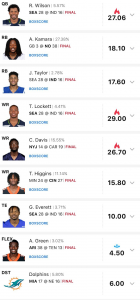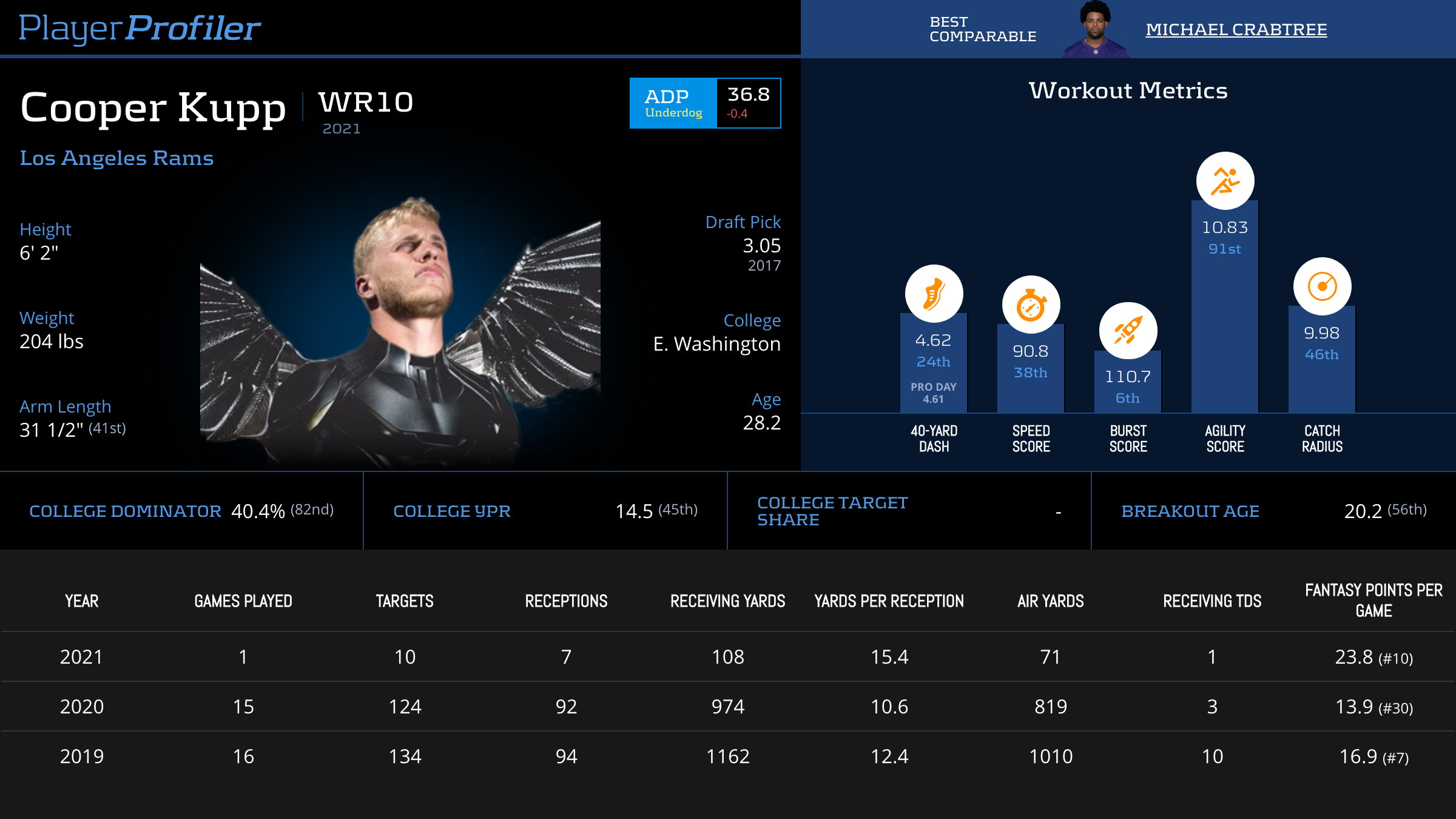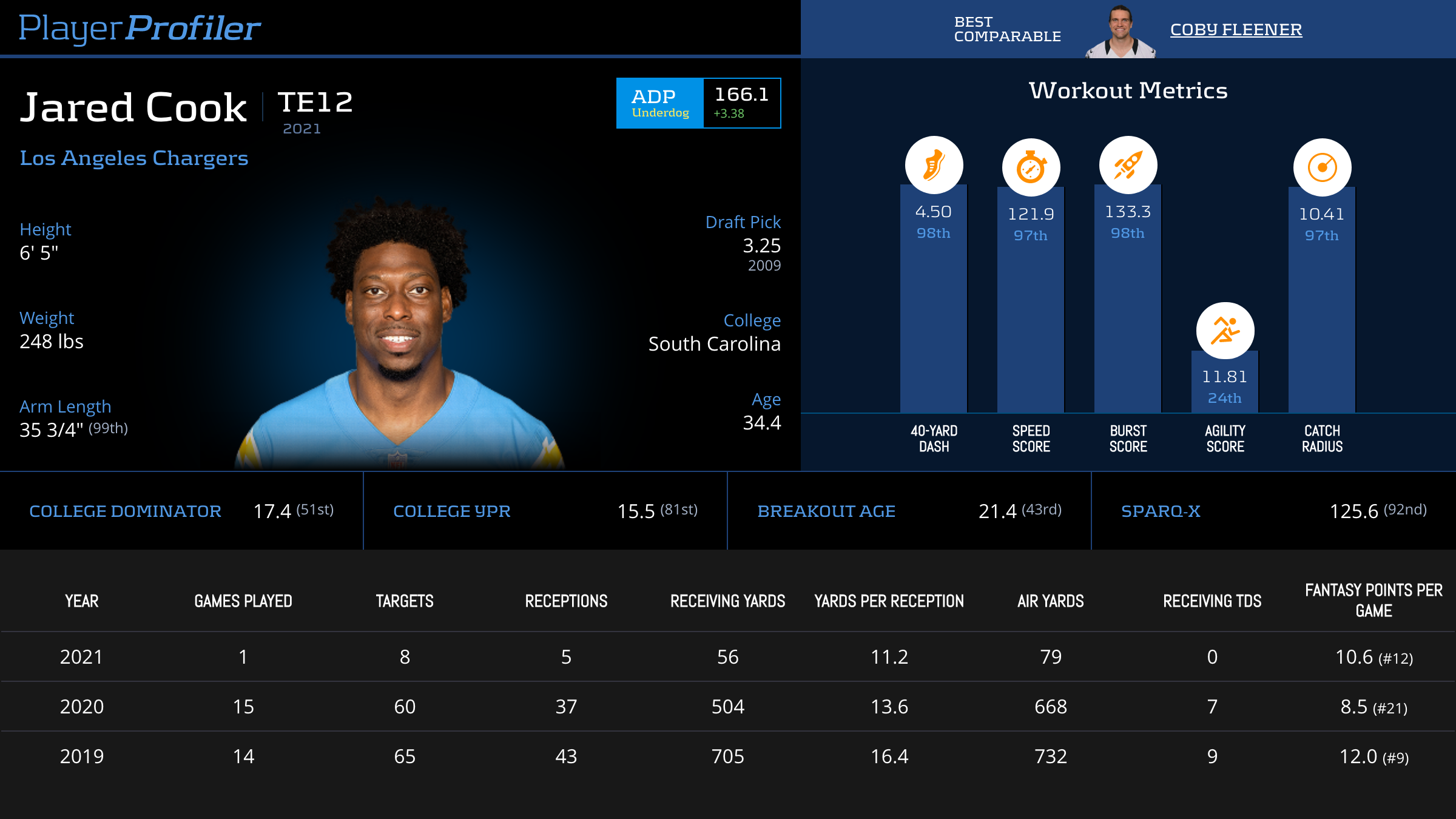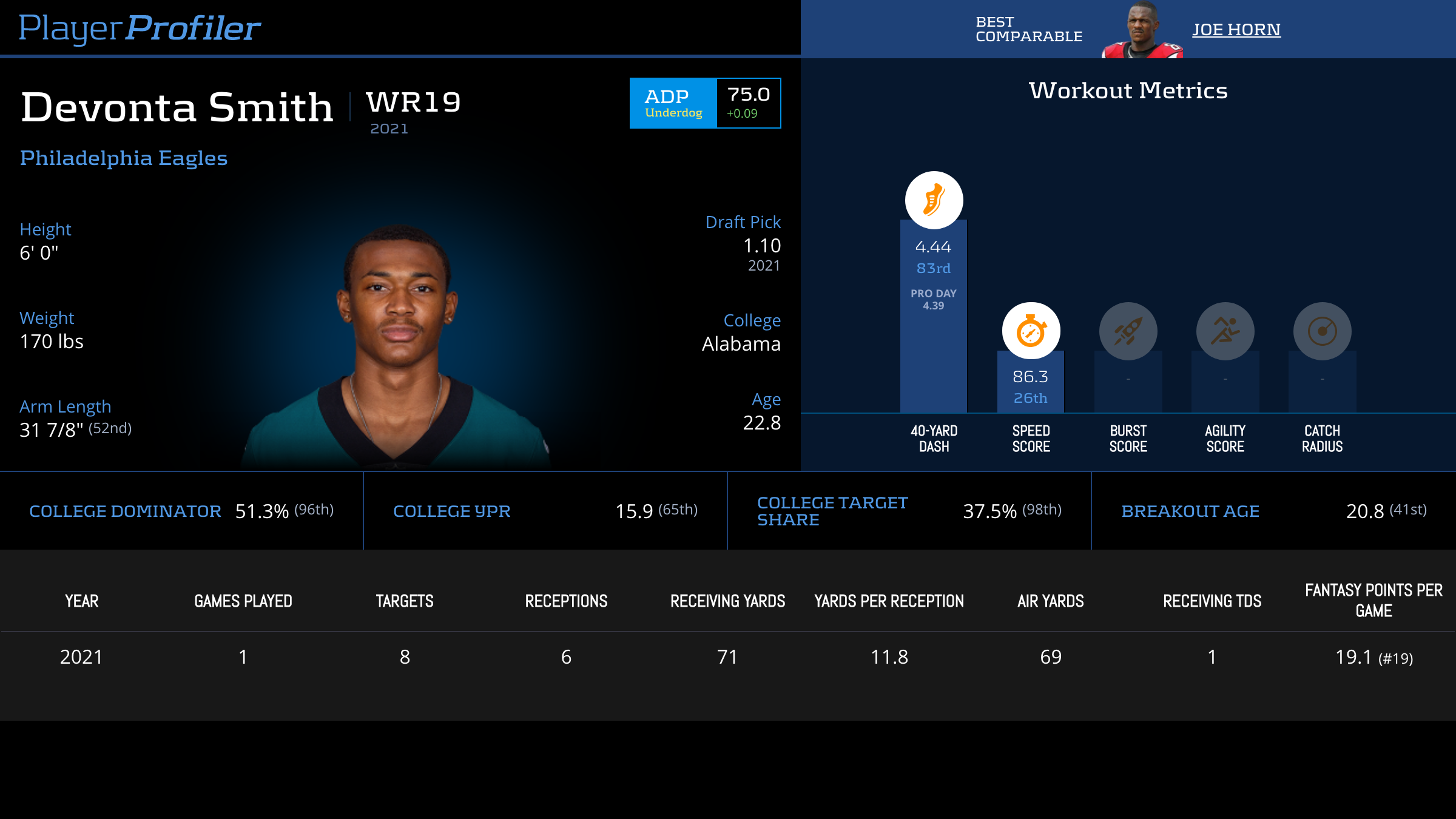Have you ever played the game 20 questions? Starting with broad categories, you proceed to narrow down your opponent’s chosen item from numerous possibilities, until you either reach 20 questions, or guess the right answer.
Let’s play.
After three questions you know my item is a ‘thing,’ a ‘food,’ and a ‘fruit.’ Could it be a mango? A kumquat? a strawberry? In the universes where each of these – or any other fruit was my choice – nothing up until this point would have necessarily changed.
From last week to the divisional round, our DFS season resembles 20 questions both structurally and literally. In Week 1, we learned valuable information; but it is hard to say which data was signal, and which was noise after such a limited sample. Should the Eagles-Falcons game tell us Atlanta’s offence is terrible? Or should we be worried about opponents playing the Eagles defence? The key moving forward will be identifying which trends are worth buying, and where the market is too confident. Even the best projected outcomes are highly fragile with such little data behind them.
Let’s get after it!
The Pareto Principles: Volume II
In case you missed my Week 1 article, this is the second edition of a weekly column that will discuss limited entry, tournament DFS at the strategic level. I will then apply theoretical concepts to each week’s slate. If you want a general guide to what to expect from this column, and my guiding principles for DFS, I will refer you to my introductory article.
The Pareto Principals: Guiding Principles For Limited Entry DFS
Week 1 Review
For the first time, I have the chance to begin my piece with a review of the previous week. In this section I will not go game by game, or address the on-field role of players. By this late in the week, you’ve read plenty of reflective content; hopefully including our weekly Lessons Learned. Instead, I will discuss the lineups I played; including any notable wins, and offer an update on my results. When I examine my lineups I’m doing so at the strategic level. Am I happy with the roster percentage I played? Did I take advantage of leverage appropriately? I will not spend much time analyzing the points each play produced.
Results
This week was a perfect one for me in cash; going 100-percent on my double ups, as well as triples and 5X. However, this is not a cash column, and unfortunately it was a slight loss in tournaments. The key figure I’ll target in assessing my play is my top-one-percent-rate. If I can place materially over one-percent of my lineups in the top one-percent of tournaments, I will most likely be profitable long term
Below you can view my top lineup for Week 1. This took 17th in a 431-person small-field single entry. All in all, I’m thrilled with it. Colts-Seahawks, along with Bills-Steelers were my two favourite game-stacks as both had high totals, but with much lower ownership than comparable games. The four pieces of my stack had a cumulative ownership of 16.47-percent: it’s hard to ask for better. This allowed me to fill out my lineup with three of my favourite chalk plays; Alvin Kamara, Tee Higgins, and Corey Davis.

Strategic Reflections
A.J. Green was one of my favourite leverage plays this week. With Rondale Moore quite popular, the chance to slot in Green – who ran as the Cardinals’ WR2 – at 3.02-percent ownership was very attractive. Had Christian Kirk‘s touchdowns gone to Green instead, this lineup would have hit fourth place. Had Jonathan Taylor‘s touchdown not been called back for holding, this lineup would have been sixth. I don’t say this to tilt, but as a reminder that the margin between a major profit and a losing week is razor thin. Overall, I was pleased with the roster percentage I got on both this, and my Bills lineups, and managed to get a ‘shot on goal.’
If I had one regret it was not opting for a Chiefs double-stack. Given the attraction of Cardinals-Titans and Eagles-Falcons, the Chiefs became underplayed relative to their upside and projection. Ultimately I made the choice to avoid lineups that forced me into playing multiple, cheap, chalk receivers such as Rondale Moore, Elijah Moore, and Marquez Callaway. However, with viable options such as Jaylen Waddle available and productive at low ownership, it was worth attempting.
Strategic Emphasis for Week 2
I don’t know if you’ve heard, but the Chargers-Cowboys game may be high-scoring this week. With an over-under of 54.5 and a tight spread, DFS players from near and far are making the pilgrimage to jam Chargers and Cowboys into their DraftKings lineups this week. In early week PFF ownership projections, Keenan Allen, Amari Cooper, and Ceedee Lamb all rank among the top four rostered receivers. The first decision you need to make for each lineup this week is whether this game will be the focus of your entry. The rest of your lineup needs to be constructed around that basis from an ownership perspective.
One of the most meaningless elements of tournament DFS is player exposure. Simply saying “I’m high on Cooper Kupp this week” has little inherent value. While it’s possible Kupp is the highest scoring receiver this week, playing him on that basis is a cash-game mindset. He projects as one of the best point per dollar options at $6000 on DraftKings, but this makes him neither a good or bad play. If you’re stacking Cowboys-Chargers, adding in Kupp as a one-off is a poor process decision. If, however, your primary stack is the lesser targeted Bills-Dolphins, opting for the projected Kupp makes a lot of sense.
Lineups Not Players: Building Upon Your Context
Many people view finishing first as dependent on finding the nine highest scoring players on the slate. But especially in smaller field contests, that is far too high a bar to place on yourself. The odds of hitting on nine uncorrelated outcomes out of a large payer pool are astronomical; significantly worse than beating the size of your field.
Tournament DFS is played against people, not the salary cap. If you stack Cowboys-Chargers, a large number of your opponents now rely on the same win condition as you do. Thus, if you hit – you need to find unique ways to reach your win condition that excludes them. Stacking highly rostered players on top of this game, pushes you closer toward a necessity of perfection with your remaining plays, since so many people are benefiting from the same outcomes you are.
Surviving The Chalk
You know I’m a fan of education via metaphor. Consider the game show Survivor: fans will criticize large alliances for turning on each other rather than voting out all other remaining tribe mates first. In reality, that’s often the smart move. In Survivor – like DFS – your expected value is disproportionately a function of first place equity. Thus, being in the controlling alliance is key, but the ideal alliance has the fewest people necessary to control the vote. You need to maximize your chances of surviving each round, as well as your win equity in the end game.

Rob Cesternino was the first to solely ‘flip’ on his alliance in order to advance his unique win condition in season six
Back to football; think back to my lineup last week. With a half left to play in the afternoon slate, I was drawing live for first place despite 4.50 from A.J. Green, and average finishes from Tee Higgins and Jonathan Taylor. This is because – prior to the Chiefs comeback – the Seahawks stack was so effective and hardly rostered, I had very few opponents to beat with the rest of my lineup.
So you Want To Play Chargers-Cowboys…
It makes sense why this game is so popular. If you want access to this potential shoot-out, what is the best way to approach it?
It's rare that we get the shootout potential that we're seeing in the LAC/DAL game this week.
Since the beginning of 2013, there have only been 22 games with an over/under of at least 55 and a spread below 4 like we're seeing here
— TJ Hernandez (@TJHernandez) September 15, 2021
As Nicollo Machiavelli once said, in any war a leader should choose a side.
If you’re playing this game, you should either aim to maximize the benefit of the shootout, or target players who will minimize the benefit of your opponents. For example, if you play CeeDee Lamb–Keenan Allen in a skinny stack, you are now reliant on this game shooting out, but you’re losing out to teams with the quarterbacks if this game reaches its maximum potential.
If you’re playing premium assets, play the full game stack. However, outside of very small fields I would stick to a ‘2+1’ rather than incorporating multiple skill position players from either side. Remember, you’re playing a highly rostered combination as your core, so you’re increasing the threshold of production for the rest of your lineup. I prefer four ‘3+1’ or ‘3+2’ stacks in under-rostered games where I can gain a larger advantage on the field solely from my game shooting out.
A Stars and Scrubs Mindset
A popular strategy in auction formats and cash-games is stars and scrubs; spending up on top assets and filling the rest of your lineup with low investment plays. While not in terms of price, this should be applied to your Chargers and Cowboys game stacks. Two players who set for low ownership in positive game environments this week include Miles Sanders and Justin Jefferson. Bad touchdown luck – Jefferson being ruled down, and Sanders being vultured – left a biter taste in managers’ mouths but the peripheral roles still look strong.
The Arizona-Minnesota game is an excellent DFS environment that may go under the radar this week due to Cowboys-Chargers and Seahawks-Titans. If the narrative regarding Chandler Jones vs. The Vikings’ backup left tackle scares the field away, I am willing to hold strong on a game with a high total and tight spread. I also would consider throwing in Corey Davis as a one-off. His role in week one was excellent, he paid off, and yet he’s likely to be under-rostered due to a fade of the general game environment. Don’t be surprised if Davis hits big for your fantasy lineups despite a low scoring game, just as he did last week.
Cooking Up Some Leverage
If you’re playing a one-off in this game, make it someone who will be under-owned and creates leverage on the field by taking points out of others’ lineups. Two options are the running backs; both of whom should be popular, but have negative sentiment after Week 1 due to Ezekiel Elliott‘s lack of production overall, and Austin Ekeler‘s failure to secure a target. As discussed in the opening; Week 1 answers the first of many questions. It remains plausible Elliott’s usage was solely due to a game-plan against Tampa Bay’s imposing front, and Ekeler’s pass game usage was a symptom of his hamstring injury. We’ve already seen broad assumptions about role changes prove incorrect on the Thursday slate when J.D. McKissic provided a slate-winning performance after game flow suited his role better than in Week 1.
My favourite play in this game however, is Jared Cook.
If his projected roster percentage increases over the weekend, I may retract this, but for now he projects as an excellent standalone play with the ability to take touchdowns out of Mike Williams and Keenan Allen lineups and into yours. I expect Tyler Higbee – who had an exemplary Week 1 role – and Noah Fant – who may see more targets after the injury to Jerry Jeudy – to dominate ownership as affordable tight ends. But the veteran Cook was top five in Air Yards and Slot Snaps at the position in Week 1, and was targeted on 29-percent of his routes. When a player sits at the intersection of game theory, projection, and game environment, you jam them into your lineups.
Alternative Game Stacks
I already touched on Vikings-Cardinals, but my other favourite game to target this week is 49ers-Eagles. Both Arizona and Minnesota ranked top-eight in situation neutral pass rate in Week 1. You know who joined them? Philadelphia. The arrow should be up on every Eagle, because Nick Sirianni’s team ran a high-pace, pass-happy scheme that put each of their playmakers in a position to succeed for the Eagles and your fantasy lineups. The usage was especially encouraging for Devonta Smith, who was third in the entire league in Week 1 Air Yards Share.
Given the uncertainty around the 49ers running backs and wide receiver rotations, there are a plethora of options to target in this game. My favourites will be skinny stacks of Miles Sanders with George Kittle, as well as full game stacks pairing Jalen Hurts with Devonta Smith, and one of the secondary pass catchers. After his muted week 1, Kittle is my favourite bring back, but I am not afraid of taking shots on Trey Sermon or Brandon Aiyuk as ultra-contrarian plays in large fields.
The Final Word
This week’s article focused on the “choose your own adventure” you are tasked with solving in relation to an electric game environment. By alternating sharp lineups around popular game stacks, and targeting under-rostered game environments, you are setting yourself up for the highest win equity. As always, enjoy the games and I’ll see you back here next week to break down everything that happened as we answer more questions in our never ending search for answers.





